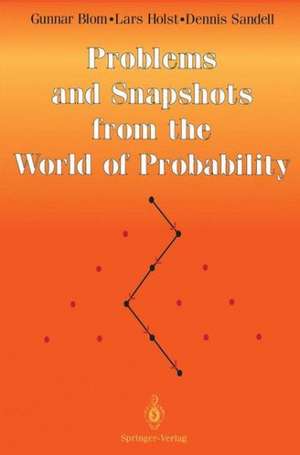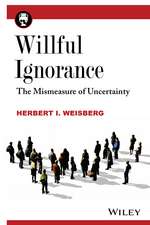Problems and Snapshots from the World of Probability
Autor Gunnar Blom, Lars Holst, Dennis Sandellen Limba Engleză Paperback – 2 dec 1993
Preț: 386.00 lei
Nou
Puncte Express: 579
Preț estimativ în valută:
73.87€ • 76.84$ • 60.98£
73.87€ • 76.84$ • 60.98£
Carte tipărită la comandă
Livrare economică 14-28 aprilie
Preluare comenzi: 021 569.72.76
Specificații
ISBN-13: 9780387941615
ISBN-10: 0387941614
Pagini: 256
Ilustrații: XII, 256 p.
Dimensiuni: 155 x 235 x 16 mm
Greutate: 0.37 kg
Ediția:1994
Editura: Springer
Colecția Springer
Locul publicării:New York, NY, United States
ISBN-10: 0387941614
Pagini: 256
Ilustrații: XII, 256 p.
Dimensiuni: 155 x 235 x 16 mm
Greutate: 0.37 kg
Ediția:1994
Editura: Springer
Colecția Springer
Locul publicării:New York, NY, United States
Public țintă
Lower undergraduateCuprins
1. Welcoming problems.- 1.1 The friendly illiterate.- 1.2 Tourist with a short memory.- 1.3 The car and the goats.- 1.4 Patterns I.- 1.5 Classical random walk I.- 1.6 Number of walks until no shoes.- 1.7 Banach’s match box problem.- 1.8 The generous king.- 2. Basic probability theory I.- 2.1 Remarkable conditional probabilities.- 2.2 Exchangeability I.- 2.3 Exchangeability II.- 2.4 Combinations of events I.- 2.5 Problems concerning random numbers.- 2.6 Zero-one random variables I.- 3. Basic probability theory II.- 3.1 A trick for determining expectations.- 3.2 Probability generating functions.- 3.3 People at the corners of a triangle.- 3.4 Factorial generating functions.- 3.5 Zero-one random variables II.- 3.6 Combinations of events II.- 4. Topics from early days I.- 4.1 Cardano — a pioneer.- 4.2 Birth of probability.- 4.3 The division problem.- 4.4 Huygens’s second problem.- 4.5 Huygens’s fifth problem.- 4.6 Points when throwing several dice.- 4.7 Bernoulli and the game of tennis.- 5. Topics from early days II.- 5.1 History of some common distributions.- 5.2 Waldegrave’s problem I.- 5.3 Petersburg paradox.- 5.4 Rencontre I.- 5.5 Occupancy I.- 5.6 Stirling numbers of the second kind.- 5.7 Bayes’s theorem and Law of Succession.- 5.8 Ménage I.- 6. Random permutations.- 6.1 Runs I.- 6.2 Cycles in permutations.- 6.3 Stirling numbers of the first kind.- 6.4 Ascents in permutations.- 6.5 Eulerian numbers.- 6.6 Exceedances in permutations.- 6.7 Price fluctuations.- 6.8 Oscillations I.- 6.9 Oscillations II.- 7. Miscellaneous I.- 7.1 Birthdays.- 7.2 Poker.- 7.3 Negative binomial.- 7.4 Negative hypergeometric I.- 7.5 Coupon collecting I.- 7.6 Coupon collecting II.- 7.7 Ménage II.- 7.8 Rencontre II.- 8. Poisson approximation.- 8.1 Similar pairs and triplets.- 8.2 ALotto problem.- 8.3 Variation distance.- 8.4 Poisson-binomial.- 8.5 Rencontre III.- 8.6 Ménage III.- 8.7 Occupancy II.- 9. Miscellaneous II.- 9.1 Birthdays and similar triplets.- 9.2 Comparison of random numbers.- 9.3 Grouping by random division.- 9.4 Records I.- 9.5 Records II.- 9.6 A modification of blackjack.- 10. Random walks.- 10.1 Introduction.- 10.2 Classical random walk II.- 10.3 One absorbing barrier.- 10.4 The irresolute spider.- 10.5 Stars I.- 10.6 Closed stopping region.- 10.7 The reflection principle.- 10.8 Ballot problem.- 10.9 Range of a random walk.- 11. Urn models.- 11.1 Randomly filled urn.- 11.2 Pólya’s model I.- 11.3 Pólya’s model II.- 11.4 Pólya’s model III.- 11.5 Ehrenfest’s model I.- 11.6 Ehrenfest’s game.- 11.7 A pill problem.- 12. Cover times.- 12.1 Introduction.- 12.2 Complete graph.- 12.3 Linear finite graph.- 12.4 Polygon.- 12.5 A false conjecture.- 12.6 Stars II.- 12.7 Inequality for cover times.- 13. Markov chains.- 13.1 Review I.- 13.2 Review II.- 13.3 Random walk: two reflecting barriers.- 13.4 Ehrenfest’s model II.- 13.5 Doubly stochastic transition matrix.- 13.6 Card shuffling.- 13.7 Transition times for Markov chains.- 13.8 Reversible Markov chains.- 13.9 Markov chains with homesickness.- 14. Patterns.- 14.1 Runs II.- 14.2 Patterns II.- 14.3 Patterns III.- 14.4 A game for pirates.- 14.5 Penney’s game.- 14.6 Waldegrave’s problem II.- 14.7 How many patterns?.- 15. Embedding procedures.- 15.1 Drawings with replacement.- 15.2 Repetition of colours.- 15.3 Birthdays revisited.- 15.4 Coupon collecting III.- 15.5 Drawings without replacement.- 15.6 Socks in the laundry.- 15.7 Negative hypergeometric II.- 15.8 The first-to-r game I.- 16. Special topics.- 16.1 Exchangeability III.- 16.2 Martingales.- 16.3 Wald’s equation.-16.4 Birth control.- 16.5 The r-heads-in-advance game.- 16.6 Patterns IV.- 16.7 Random permutation of 1’s and (?1)’s.- 17. Farewell problems.- 17.1 The first-to-r game II.- 17.2 Random walk on a chessboard.- 17.3 Game with disaster.- 17.4 A rendezvous problem.- 17.5 Modified coin-tossing.- 17.6 Palindromes.- References.













